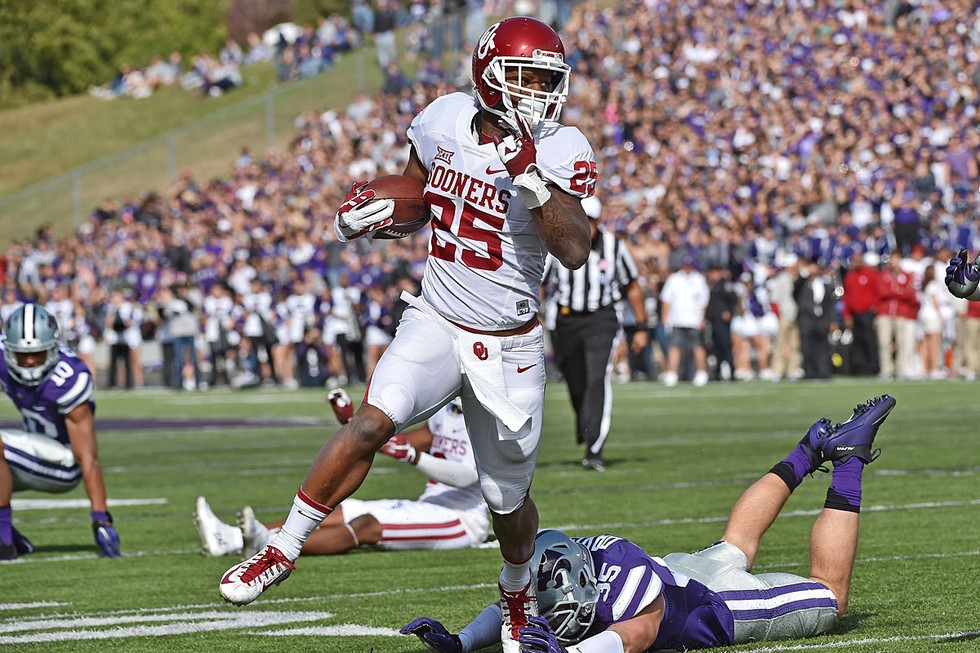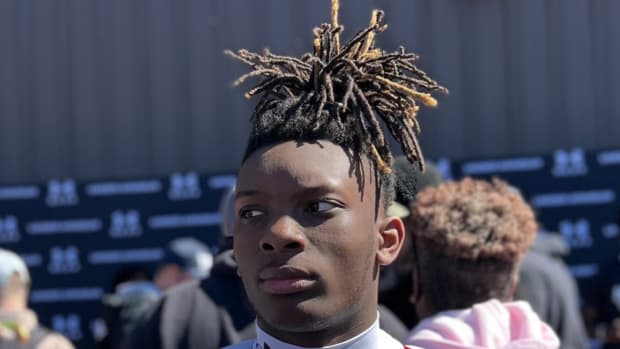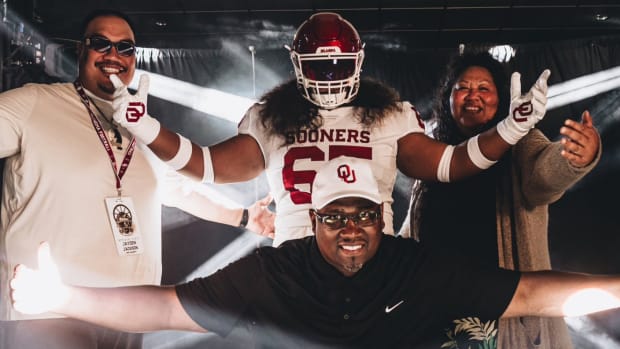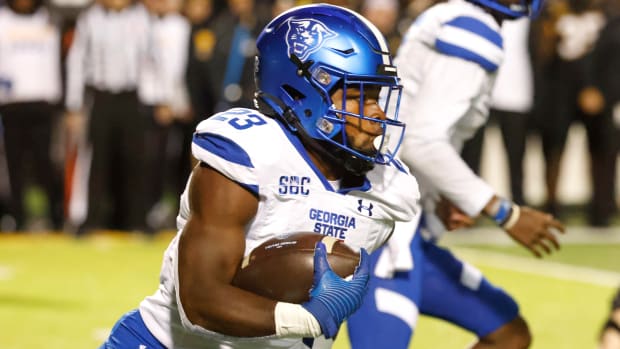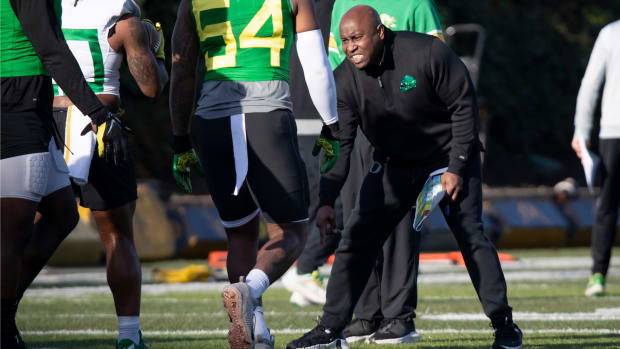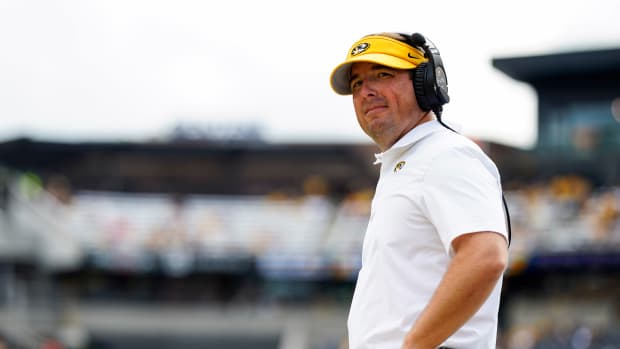Oklahoma's Joe Mixon finally faces media, but refuses to answer questions about violent incident
MIAMI GARDENS, Fla. — He started his media availability, as many athletes in this era do, by posing for a selfie, making sure anyone who would later view the photo could see all those gathered to talk to him.
Yes, 522 days after becoming infamous, Joe Mixon finally faced the media Tuesday morning at Orange Bowl media day.
Mixon told the roughly 50 reporters gathered around his small table that he was there to answer football questions only, a point previously made clear by an Orange Bowl representative who said that any media member who didn't stick to the script would be asked to leave. This, for a player who was making his first public media appearance since he punched a female Oklahoma student and broke bones in her face in four places in July 2014—and who was allowed to stay on scholarship and earn his way back on to coach Bob Stoops's football team.
But rather than answer questions, Mixon deflected them, just as he has done all season with would-be tacklers in the Sooners' drive to the College Football Playoff semifinal Thursday against Clemson.
Two months before former Baltimore Ravens running back Ray Rice blew up America's willingness to tolerate an athlete's violence against women, Mixon was granted a second chance by one of the premier programs in college football, which is on the verge of playing for its eighth national championship.
Mixon is one of the most talented tailbacks in college football. The 6' 1", 217-pound redshirt freshman averaged 6.8 yards per carry, gained 749 rushing yards and 345 receiving yards, and scored 11 touchdowns this season for 11–1 Oklahoma. He came to Norman from Oakley, Calif., as a five-star recruit lauded for his playmaking ability. And this fall, Mixon and sophomore tailback Samaje Perine have formed one of the best rushing tandems in the country. Mixon's play has been crucial for a team determined to show last year's 8–5 season was a fluke, and that the Sooners still belong in college football's upper tier.
Mixon pleaded in October 2014 to a misdemeanor assault charge stemming from an incident the month before outside a Norman restaurant. Days before the Sooners started fall camp, Mixon punched a female student, knocking her to the ground and breaking her jaw. Yes, the victim put her hands on Mixon first. There is no doubt this is a complicated situation, but that's not an excuse. This is a clear-cut issue. Hitting a woman should never be accepted. Ever.
It's 2015, and we like to say we take these issues seriously.
But really, do we take them seriously enough?
The victim underwent surgery and Mixon was suspended from the football program for a year in August 2014. Except he was kept on scholarship, and he did not lose any NCAA eligibility. Oklahoma lists 2014 as a redshirt season for Mixon. So he sat out his first year on campus (which is common for freshmen at major college football programs) and he didn't practice.
Jackson Laizure/Getty Images
Some fans think this story is old news and that the media needs to move on. As soon as Mixon is willing to answer some questions—remember, this is first time he has spoken to reporters since the incident—we will. Alas, he wasn't interested in that Tuesday. (Mixon said his lawyer advised him not to answer any nonfootball questions on Tuesday.)
Asked if he had a desire to answer any nonfootball questions, Mixon said no.
Asked if he thinks he should answer those, he said, "Not here."
Asked if he was worried about alienating female football fans, he said, "Next question."
Asked if he feels sorry for what happened, he said, "I won't answer that."
He credited his coaches, teammates and girlfriend with helping him stay the course in his year off the field.
Early in the media session, Mixon said he would describe himself as a great person, and I—one of the few female sports reporters in the scrum—followed up, asking why he would choose to use that adjective. He answered by saying that if we got to know him, we would see how he was and become convinced.
Mixon may not understand it yet, but great people are about action, not talk. If someone is truly great or humble or intelligent, he or she shouldn't have to say so. Great people answer the tough questions and confront difficult situations simply because they hold themselves to a higher standard.
Would the female he punched—or her father—describe Mixon as a great person? Would any person off the street who is not an Oklahoma fan read about Mixon's off-field situation and say he is great? If a man struck Mixon's girlfriend, Taylor Sibella, or Stoops's daughter, Mackenzie, and broke four bones in her face, would Mixon describe that guy as a great person?
In the spring, Oklahoma president David Boren expelled two students who had led racist chants during an Sigma Alpha Epsilon fraternity event that had been captured on video. In a press release, Boren praised his school for how it handled the divisive video, saying: "I am extremely proud of the reaction and response expressed by our entire university family—students, faculty, staff, and alumni about this incident. They are 'Real Sooners' who believe in mutual respect for all."
Perhaps he meant to say "for all men," because allowing one male student to break the jaw of a female student and remain on scholarship is anything but mutually respectful.
In the wake of the SAE incident, Sooners senior linebacker Eric Striker became a spokesman for social justice, passionately condemning racism and demanding that his campus and community recognize the need for a zero-tolerance policy. Striker is one of the most thoughtful and engaging athletes in sports today. And it's great that Oklahoma, as a football program and a university, is represented by someone like him, as well as by senior center Ty Darlington and redshirt junior quarterback Trevor Knight, who also took strong stands on the issue.
But the school is also represented by Mixon, redshirt senior linebacker Frank Shannon (suspended in 2014 following a Title IX sexual assault investigation) and, last year, by wide receiver Dorial Green-Beckham (welcomed to Oklahoma after being dismissed from Missouri in April 2014 following accusations of physically assaulting two women).
When asked about this, athletic director Joe Castiglione said each case is different, and advised reporters to look into Oklahoma's track record before concluding that the program has created a culture tolerant of violence against women. I did: Mixon, Shannon and Green-Beckham—three tremendously talented athletes, each with the skills to help the Sooners win football games, and each with a well-known history of disrespecting women. What was that about mutual respect?
I asked Striker and Darlington, both of whom will riff on pretty much any topic, if they had concerns about Oklahoma looking hypocritical in all of this. The Sooners are arguably the most socially conscious team in collegiate athletics: They want to set the tone not just in how they win championships, but also in how they speak out for what they believe. Yet here they are, in the College Football Playoff, partially because their coaching staff and administration were willing to welcome back a player who punched a woman.
To their credit, Striker and Darlington answered the question. Striker said he believes people make mistakes and shouldn't be judged solely for them. Darlington said this is a nuanced issue that can't be wrapped up in a 15-second sound bite.
Both are correct, but still I'd like to ask Mixon a few of those prohibited nonfootball questions:
Why does this program get to pick and choose when it takes a stand on a touchy subject?
Why did he deserve a second chance, and why did that chance get to come at the highest level?
Do the Sooners, a championship-level program, hold themselves to the highest standard?
Is he remorseful?
What would he say to a young girl in Norman who asks her parents why that football player they cheer for hit someone like her?
And finally, this: Does he worry about his image, or has he reached the same conclusion as the 85,000-plus fans who stand in thunderous applause every time he scores a touchdown in Norman?
The video of Mixon's punch isn't available to the public, so he continues to skate by. There might be lots of dispute about him being a great person, but everyone can agree he is a great football player.
